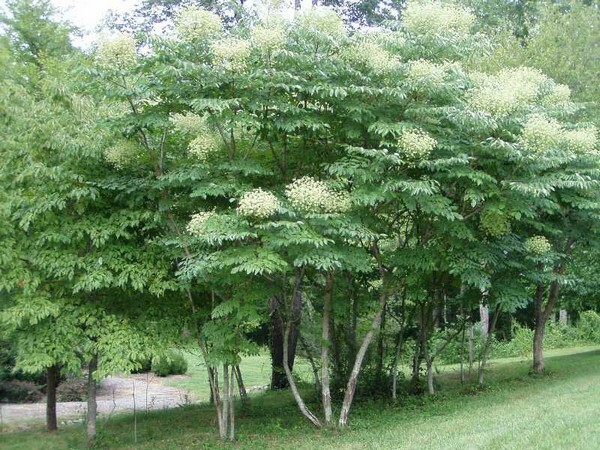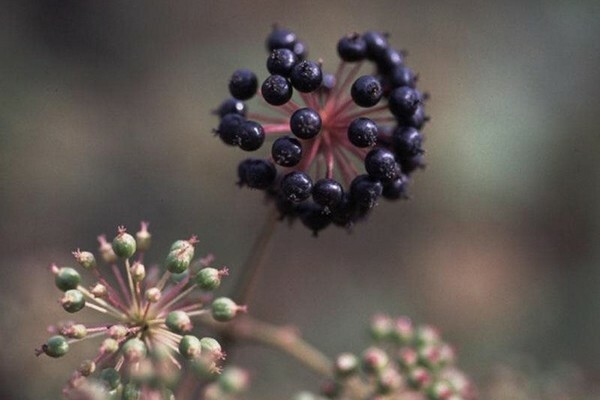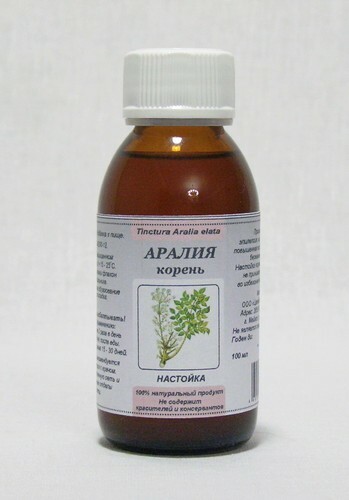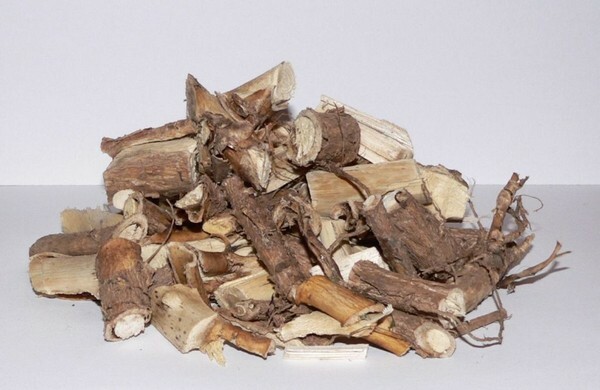Aralia Manchu or Aralia high is a medicinal plant of the genus Aralia, belonging to the family Aralii, which is a shrub or small, up to 5 m tall, tree. In nature, it occurs in forests in the Far East, Japan, Korea and China. However, it can easily be grown independently in a summer residence or in a garden for decorative or medicinal purposes. The plant can become not only a beautiful decoration of the territory, but also used as a hedge. Means from roots and other parts of Aralia have long been used in eastern folk medicine for neurological disorders, fatigue, hypotension and other diseases. In the people because of the characteristics of the trunk and branches covered with sharp thorny thorns, the plant received the name of a spike-tree, a devil's truncheon or a devil's tree.

Botanical description of
In the natural environment, the Aralia Manchurian grows individually or in groups of several pieces, mainly in well-lit clearings and fringes. It can form impenetrable dense thickets, rapidly growing on devastated places where there are no other trees. The plant is frost-resistant, not prone to fungal diseases and pest damage. The devil's tree reproduces seeds or root offspring, the maximum period of his life is 30 years.
The Manchu Aralia has a straight trunk up to 20 cm in diameter, at the top of which there are leaves. Outside, it is covered with a wrinkled bark of a yellowish-gray color with numerous sharp spines of triangular shape. These spines are also present on the branches of the plant.
Interestingly: The most prickly are young plants, spikes are present not only on the trunk and branches, but even on the petioles of leaves.
The root system is radial, superficial. At a distance of 1.5 - 2 m from the base of the soil, the roots sharply bend and go down. Outdoors, they are painted in brown, inside white, with a fibrous structure.
The leaves are very large( up to 100 cm long, 40 - 60 cm wide), located on brownish-red petioles up to 20 cm long at the top of the trunk. They are twice-pinnatulous in type, they consist of 2-4 lobes of the first order, on each of which there are from 5 to 9 pairs of ovoidly pointed leaves. On top of the leaves are bright green, from below the color is more faded, in autumn they acquire a purple color.
Blossom Aralia Manchu begins for the fifth year of life. Small yellowish-white or cream flowers contain both stamens, pistils and only stamens, and have a pleasant aroma. They are collected in complex inflorescences with a diameter of 40 - 45 cm, adorning the tops of trees. During the flowering period, which occurs in July-August, the plant is of special decorative value.

Fruits, which are small globular berries of blue-black color, ripen in the beginning of autumn. Their diameter is 3 - 5 mm, inside each fruit there are 5 bones with elongated seeds of light brown color.
Chemical composition of
The healing properties of Manchurian aralia are due to the presence of biologically active compounds important for humans in various parts of the plant. The most valuable are the roots, which contain:
- gums;
- resins and tannins;
- starch;
- vitamins( C and B groups);
- triterpene saponins( aralozides A, B and C);
- alkaloids( aralin);
- minerals( K, Fe, Ca, Mn, Mg, Cu, Zn, Se, etc.);
- flavonoids;
- coumarins;
- proteins;
- essential oil.
The leaves and branches of the spike-tree are composed of organic acids, essential oil, anthocyanins, alkaloids, carbohydrates and triterpenoids. Seeds are rich in unsaturated fatty acids.
Therapeutic properties of
In folk medicine, funds from the Aral Sea of Manchuria have been used with general weakness after the diseases suffered by the body, impotence, diabetes, nervous, physical and mental exhaustion, depression, for the treatment of post-traumatic conditions. They enhance the functional activity of the central nervous system, enhance the body's defenses and its resistance to nervous stresses, infections, poisoning toxins, hypoxia and other adverse factors. In addition, they have the ability to reduce the concentration of glucose and lipoproteins in the blood. Decoction of the roots of the plant is effective for colds, diabetes, pathologies of the digestive tract, inflammation in the mouth, kidney disease, enuresis.
Aralia is also used for diseases of the skin caused by metabolic disorders. When receiving funds from it a person observes:
- improvement of well-being;
- normalization of blood pressure and vascular tone;
- improved appetite;
- improved metabolism;
- sleep normalization;
- increase of working capacity;
- relief of heart and headaches.
It is interesting: A fragrant and delicious drink called "Aralman" is prepared from the extract of Aralia. It perfectly refreshes, quenches thirst and exerts a tonic effect.

Aralia Manchurian is used for medicinal purposes not only in folk medicine, but also in traditional medicine. In particular, the pharmaceutical industry produces an alcoholic tincture of plant roots, as well as preparations of Saparal and Safinor. Saparal tablets consist of crushed and compressed roots of the Aralia Manchu, are prescribed for neurasthenia, depression, asthenia, hypotension, mental and physical overwork. Safinor is a combined medicine and, in addition to the extract of Aralia Manchurian, contains a preparation of the roots of the Siberian swell, Inosin and Potassium orotate. It can be taken by athletes with exhausting physical exertion, as well as people who have had severe illnesses, during the recovery period.
Thanks to the stimulating effect of the Aralia, the Manchu is used in sports. Funds from its roots athletes often take in the morning before training. They help to increase the physical, adaptive capabilities and energy output of the body, have the ability to enhance the anabolic processes necessary to effectively build muscle. In this regard, the Aralia Manchurian is popular in bodybuilding, its athletes use during the period of carbohydrate loading.
Procurement of raw materials
The bark, leaves and roots of the Manchu Aralia are used as medicinal raw materials. The bark and roots are harvested in the spring until the appearance of leaves or in the autumn after the shedding of the fruit. Collection of leaves is carried out during and after flowering.
The roots of plants of 5 to 15 years old, whose diameter is 1-3 cm, are considered suitable for medicinal purposes. They are excavated from the soil, leaving part of the pristine to restore the thickets of the Aral Sea. Then they are shaken from the remnants of the earth, the blackened and decayed areas are removed, washed and cut into pieces of 8 to 10 cm in length. Dry in warm rooms with good natural ventilation or special dryers at a temperature of 55-60 ° C.For bark and leaves, the drying temperature should be slightly lower( 50 - 55 ° C).

Shelf life of the finished raw material when stored in paper bags or bags in a cool place is 2 years.
Important: It is possible to collect the roots of Aralia on the same site once every 10 years.
Ways of using
In folk medicine from the Aralia Manchurian prepare decoctions, water infusions and alcohol tincture. It is not recommended to use these drugs before going to bed, as they have an excitatory effect on the nervous system, which can trigger sleep disturbance.
Tincture of the roots
To get the Manchu tincture from Aralia, 40 g of the dried raw material should be poured into 200 ml of alcohol( with the ethanol content of 70%).The resulting mixture is insisted for 2 weeks, periodically mixing. At the end of the time, strain and squeeze. Take 35 drops 2 to 3 times a day during meals during the month with asthenia, depression, sexual weakness, fatigue.
Root broth
Roots of Aralia( 20 g) pour ¾ glasses of hot water, boil, cover with a lid, 30 minutes, then allow to cool for 10 minutes and filter. Take 15 ml three times a day before meals for 14 to 20 days with diseases of the digestive tract, kidneys, colds, diabetes, enuresis and as a general restorative.
Infusion of leaves and flowers
A mixture of leaves and flowers of Aralia( 20 g) pour 200 ml of steep boiling water and put for 15 minutes in a water bath. Then the resulting infusion is cooled, filtered and drilled three times a day for 60 ml. The product is used for medical and cosmetic purposes, adding to face masks, tonic lotions and compresses.
Precautions
Means from Aralia Manchurian have curative properties and contraindications. They can not be used in the case of:
- of increased excitability;
- of insomnia;
- arterial hypertension;
- epilepsy;
- febrile states;
- disorders of cardiac activity;
- hyperkinesis.
In the treatment it is important to observe the dosage, as if it is exceeded, intoxication is possible, the symptoms of which are loss of consciousness, bleeding, respiratory failure.
Important: Self-medication by means of Manchu Aralia can be dangerous for the body, therefore, before starting their use, a doctor's consultation is necessary.
Video - Appearance and Properties of Manchu Aralia:
